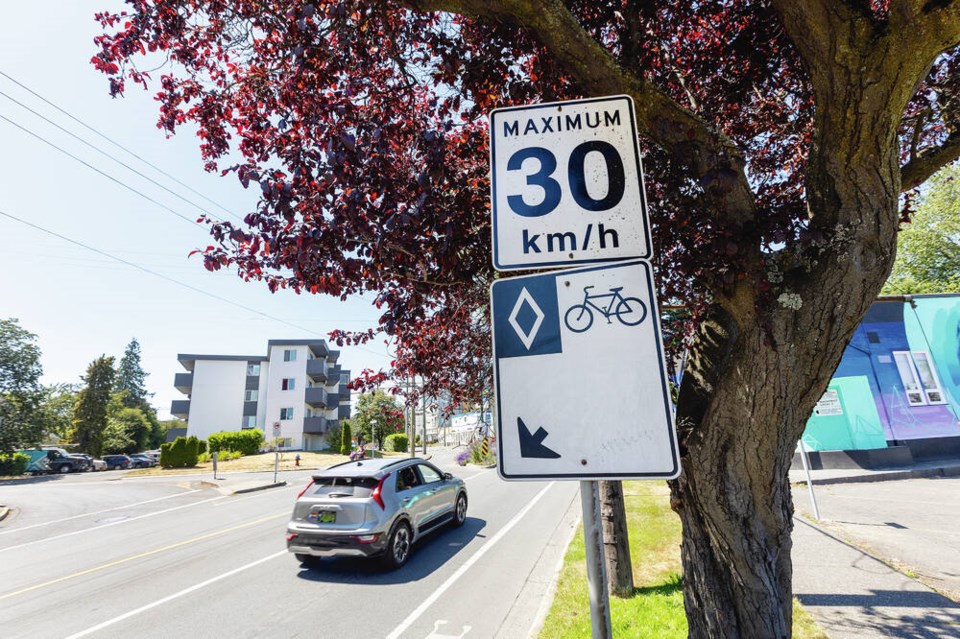I’m receiving more and more emails from readers about how hard it’s becoming to follow the rules of the road in this region — specifically about speed limits.
It’s fair to say that the limits have been effectively lowered pretty much everywhere in the capital region. Part of the problem is that “pretty much” is not an effective standard. There are still a few areas where the municipal speed is still the provincially mandated 50 km/h. The result is a recipe for confusion.
On some streets, you can be directed to adjust your speed three times within a couple of kilometres, often without a clear sense of why they needed to change in the first place.
It prompted me to look at evidence-based practices which actually make the most difference in road safety. One study, conducted by the World Bank in 2021, stood out — not only because it was so thorough but also because it went beyond analytics and number crunching — showing in plain language what works and what doesn’t.
Changing speed signs is only one small part of making roads safe.
At the top of the World Bank’s list is developing comprehensive public transport systems. Clearly the more vehicles you take off of the road, the less chance there is of people running into each other. Likewise when pedestrians are removed from proximity to vehicles in the first place there is less chance of conflict.
The obvious downside is the enormous cost of public transport. Infrastructure costs have gone through the ceiling and large scale projects today are essentially beyond the grasp of municipalities without large scale federal or provincial subsidy. No doubt the municipal request list is a very long one for senior governments.
Roadside barrier systems can significantly reduce fatalities and serious injury crashes. Leaving the roadway in a collision event is one of the most serious consequences during a crash. Barriers which keep vehicles on the road and upright significantly reduces injury and death.
Head on smash-ups are the worst of the worst in the collision hierarchy. Central medians then are highly effective in preventing these kinds of mishaps. It’s unfortunately a common occurrence on our island highways. Head on collisions mean that the vehicles involved hit each other at the combined speed of their original velocities. That means that the impact force can be momentous even at relatively low speeds.
Though still somewhat contentious in B.C., the roundabout has an evidence-based track record in reducing crashes and fatalities. A roundabout reduces not only the number of contact points in a potential collision, like you would find in a regular intersection, but also reduces the angle of impact between vehicles, greatly lowering crash severity.
In terms of pedestrian flow, the World Bank study rated several measures as “highly effective.” These measures included raised crosswalks as well as purpose-built pedestrian over- and underpasses. Raised crosswalks serve two purposes. Their elevated position in relation to the rest of the road surface puts a pedestrian much higher into a driver’s point of view, increasing their visibility. They also serve as a speed hump intended to decrease vehicle speeds.
Interestingly physically separated bike lanes were only rated as “effective” — one level below “high effective” in the World Bank study. Despite protective infrastructure, bicycles are still vulnerable to “right hook” collisions at intersections. This happens when a cyclist goes straight through an intersection but the car in the lane beside turns right just as the cyclist is passing through. Each year, there are scores of cycling fatalities North America wide as a result of the “right hook.”
What also caught my attention were the items which were deemed “ineffective.” These included post licence driver and training education in high school. Post licence training was found to lead to overconfidence in many drivers while high school-based programs especially for younger children led to false beliefs for both kids and parents that they were now “road aware” after they were given only classroom instruction.
The World Bank study did show that lowering speed limits generally is a highly effective method to reduce collisions and fatalities. But surely part of that is knowing that the limit is more or less consistent throughout a given area.
Playgrounds and school zones aside obviously, roads which have 2 or 3 different limits within a couple of kilometres, are confusing — at least according to many readers. Equally important though is ensuring that a new speed limit area is consistently and reasonably enforced. We can have all the shiny new speed signs in the world but as one pundit puts it: “Laws without enforcement are merely suggestions.”

-thumb.png;w=120;h=80;mode=crop)

